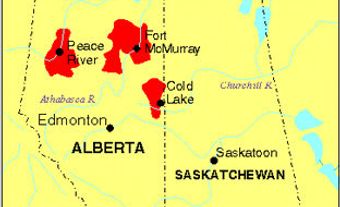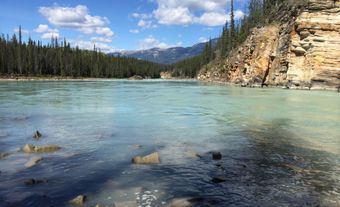
Cours
Les principaux cours d’eau nourriciers du fleuve sont la rivière de la Paix et la rivière Athabasca, alors que le cours principal tire sa source du bras occidental du Grand lac des Esclaves à proximité de Fort Providence (Zhahti Koe). Environ 300 km plus loin en aval, la rivière Liard atteint la rive sud du Mackenzie. Peu après, à proximité de la rivière North Nahanni, le Mackenzie se dirige vers l’ouest‑nord‑ouest en traversant une plaine ondulante et dévie vers le nord, au‑delà d’un escarpement des monts Mackenzie qui lui sont parallèles.
Passé Norman Wells, le fleuve poursuit sa route à travers des passages herbeux et au pied d’escarpements striés, s’élargissant jusqu’à 5 km, tressant son chemin parmi d’innombrables îles. Lorsqu’il arrive aux rapides Sans Sault, une pointe rocheuse se dresse dans le milieu du courant, rendant les eaux turbulentes et la navigation dangereuse. À quelques kilomètres en amont de Fort Good Hope, le fleuve s’élargit, puis il se resserre entre des falaises de calcaire appelées The Ramparts et reprend ses ondulations vers le nord‑ouest, ses chenaux obstrués par des îles et des bancs de sable en mouvement. À 270 km de la mer, la rivière Arctic Red (Tsiigèhnjik ou la « rivière de fer ») alimente le Mackenzie dont le delta commence à Point Separation.
Mackenzie River Delta
The Mackenzie Delta is a vast fan of low-lying alluvial islands (i.e., islands composed of river sediment), covered with black spruce, thinning northward. These trees are large enough to be used for construction of log buildings and are widely used as fuel. The delta is 80 km across, bordered by the Richardson Mountains in the west and the Caribou Hills in the east. Below Point Separation the river splits into three main, navigable channels: East Channel, which flows past Inuvik on the easterly edge of the delta; Peel Channel in the west, which flows past Aklavik; and Middle Channel, which carries the main outflow into the Beaufort Sea.
Ecology
With snowmelt and the break-up of ice in spring and summer, the Mackenzie River becomes laden with suspended sediments and dissolved solids. Year-round the river carries a greater load of such materials than any other circumpolar river. Most of these solids originate in the mountain ranges that drain into the Mackenzie from the west including the Mackenzie Mountains, and the Pelly and Rocky Mountains in the Liard sub-basin. By contrast, the waters that flow into the Mackenzie from the Great Bear River to the east are clear.
Fifty-four species of fish are found in the river, many of which move en masse between the Mackenzie and its tributaries. Those that move from the sea to freshwater in order to spawn travel some of the farthest distances. The arctic cisco, for example, travels from the delta up the Mackenzie and into the Liard River. Lake whitefish, inconnu and long-nose suckers all migrate between the Liard and the Mackenzie.
Migratory birds, including snow geese, tundra swans and sandhill cranes, use the Mackenzie River as a migration route and spend the summer months in the delta. In the spring, the delta is also a calving ground for beluga whales. The maze of channels, cutoff lakes and circular ponds that make-up the delta are also home to a thriving muskrat population that has long sustained a fur-harvesting industry. Moose, mink, beaver and wood frogs are all found along the riverbanks.
Environmental Concerns
As with other northern aquatic ecosystems, climate change and contaminants, especially long-range contaminants, pose the greatest concerns to the health of plants, animals, people and fish that live in and along the shores of the Mackenzie River. Hazards resulting from climate change are already found along the Mackenzie, including unusual floods and thinner ice roads. There is concern that as permafrost thaws, drilling waste from oil and gas exploration will be exposed and could contaminate local environments. Future changes in streamflow are also anticipated as a consequence of warming. Specifically, changes in the snowpack and melting will lead to lower water levels in spring and summer along the river, but higher levels in fall and winter. Climate change is interacting with contaminants like mercury and polychlorinated biphenyls (PCBs) that are found in the Subarctic and Arctic, but originate elsewhere. Levels of these toxins in burbot, a top predator in the Mackenzie River, and an important food source for local communities, have increased significantly since the mid-1980s. Mercury is also flowing from the Mackenzie River into the Beaufort Sea and Arctic Ocean where it is consumed by beluga whales and other species.

History
Deh Cho, the Dene name for the Mackenzie River, translates literally as “Big River.” The Inuvialuktun name, Kuukpak, meaning “Great River,” and the Gwich’in name, Nagwichoonjik, meaning“river flowing through a big country,” each capture the great scale of the river in the landscape. Its English name derives from Alexander Mackenzie, the first European to travel the length of the river to its mouth in 1789.
Inuvialuit occupied a winter village, called Kuukpak, situated near the mouth of the Mackenzie River from the 1400s until the late 19th century, when it was abandoned following epidemics of European-introduced diseases. From Kuukpak, Inuvialuit could hunt caribou and beluga, and take advantage of the abundance of driftwood that floated down the river. Fish camps that date back hundreds of years were situated on the banks of the main stem of the river. Families harvested fish from the river then moved inland to hunt caribou in the Mackenzie Mountains or on the tundra to the east, as summer changed to fall. Alexander Mackenzie and John Franklin both visited the fish camps on the river during their travels in 1789 and 1825 respectively. River fisheries increased in importance with the adoption of dog teams in the early fur trade period, as the main subsistence for the dogs during the winter months was dry fish.
The relative ease of transportation along the Mackenzie River made it the focus of activity by non-Indigenous newcomers including explorers, traders and missionaries. The North West Company established posts on the river, including the Fort of the Forks, which became Fort Simpson (Liidlii Kue, or “place where rivers come together” in South Slavey) and which served as district headquarters for the Hudson’s Bay Company in the 19th century. In 1858 and 1859, the Roman Catholic Oblate, Henri Grollier, travelled down the river, establishing missions at Fort Simpson, Tulita (Fort Norman) and Fort Good Hope (Radeli Koe).
It was just north of Tulita where Imperial Oil employees struck oil in the summer of 1920. The Canadian government, needing to secure title to these lands, promptly sent a treaty party north to obtain signatures on what would become Treaty 11. The oil discovery led to the development of a refinery at Norman Wells, which supplied petroleum products to regional industrial operations, including the mines at Port Radium and in Yellowknife beginning in the 1930s. In this period the federal government also introduced domesticated reindeer to the Mackenzie delta to encourage local economic development (particularly as the wild caribou herds had been depleted by whalers in the late 19th century). Inuvialuit worked with Scandinavian Sami herders who had moved to Canada to care for the animals.
Twentieth century transportation in the western NWT relied on the Mackenzie River. The HBC’s main supply ship, the SS Distributor, was one of several stern-wheelers and motor-powered vessels that traversed the length of the river’s stem from Fort Smith to Aklavik in the delta. Métis men often worked as pilots for these vessels. The Distributor made two or three round trips each summer from 1920 until the late 1940s, when the last stern-wheelers ceased operation on the river. The Distributor carried goods and personnel to the posts, hospitals and missions, as well as children going to northern residential schools.
In 1942, construction began on the Canol pipeline to carry crude oil from Norman Wells to Whitehorse, in the Yukon. Canol was one of several US army projects in the Northwest Territories during the Second World War that sought to ensure continental security and energy security in particular. Hundreds of American soldiers travelled down the Mackenzie River, which served as a critical transportation artery not only for Canol, but the other military projects as well. Dene also found work on these projects, as they broke trail and guided survey crews.
After the 1940s greater effort was made to construct all-weather highways in the Northwest Territories, although water routes endured into the 21st century. NWT Highway 1 reaches Wrigley on the river and there are winter ice-roads in the delta. In 2012, the Deh Cho Bridge opened. This bridge crosses the Mackenzie on NWT Highway 3 near Fort Providence and is the only permanent bridge across the river.
In 1968, a major oil strike in Prudhoe Bay, Alaska, prompted proposals to create a northern pipeline corridor to carry natural gas from the Arctic Ocean to Alberta, including along the Mackenzie River Valley. These proposals came at a time when Dene leaders were questioning the significance of Treaty 11, leading to their clear assertion, by the early 1970s, that this treaty had not ceded control over northern lands including the Mackenzie River. The Mackenzie Valley Pipeline Inquiry, led by Thomas Berger, engaged with these issues and more, recommending a 10-year moratorium on pipeline development and triggering a new land claims process. Land claims covering different sections of the river (from north to south), were settled with the Inuvialuit (1984), Gwich’in (1992) and Sahtu (1994). The Dehcho land claim, covering the southernmost part of the Mackenzie River, is still being negotiated.

 Share on Facebook
Share on Facebook Share on X
Share on X Share by Email
Share by Email Share on Google Classroom
Share on Google Classroom



